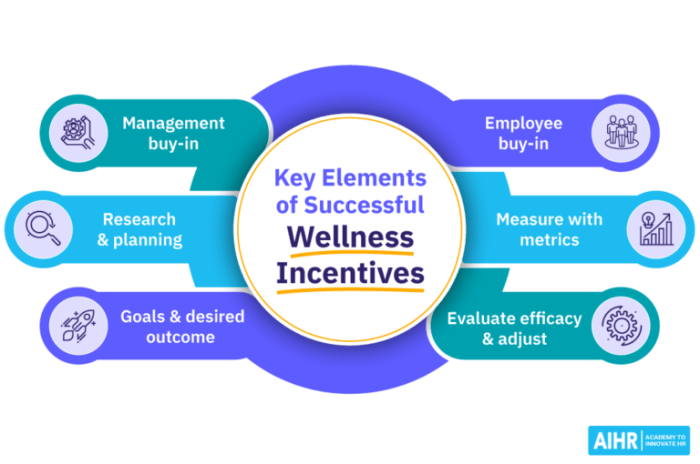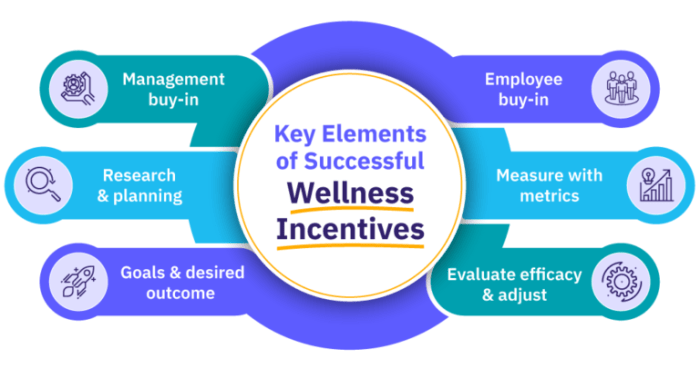Wellness Incentives in Lifestyle Health Plans sets the stage for this enthralling narrative, offering readers a glimpse into a story that is rich in detail and brimming with originality from the outset.
As we delve into the realm of wellness incentives, we uncover a world where health plans are not just about coverage but also about motivating individuals to embrace healthier lifestyles.
Overview of Wellness Incentives in Lifestyle Health Plans

Wellness incentives play a crucial role in lifestyle health plans, offering rewards or benefits to individuals who engage in healthy behaviors. These incentives are designed to motivate individuals to adopt and maintain positive lifestyle changes, ultimately leading to improved overall health and well-being.
Importance of Incorporating Wellness Incentives
Incorporating wellness incentives into health plans encourages individuals to take an active role in managing their health. By providing rewards for healthy behaviors such as regular exercise, healthy eating, smoking cessation, or preventive screenings, health plans can inspire individuals to make positive choices that promote long-term wellness.
- Financial Incentives: Health plans may offer discounts on premiums, cash rewards, or gift cards for completing health assessments, participating in wellness programs, or achieving health goals.
- Health & Fitness Benefits: Access to gym memberships, fitness classes, or wellness coaching can be provided as incentives to promote physical activity and healthy lifestyle habits.
- Wellness Challenges: Competitions, challenges, or point-based reward systems can motivate individuals to engage in healthy behaviors and track their progress towards wellness goals.
Benefits of Offering Wellness Incentives
Wellness incentives not only encourage healthy behaviors but also lead to various benefits for individuals and health plans alike. These benefits include improved health outcomes, increased engagement in wellness programs, reduced healthcare costs, and enhanced overall satisfaction with the health plan.
- Improved Health Outcomes: By incentivizing healthy behaviors, individuals are more likely to make positive lifestyle changes that can result in better health outcomes and reduced risk of chronic diseases.
- Increased Engagement: Wellness incentives can boost participation in wellness programs, leading to higher engagement levels and better adherence to health goals.
- Cost Savings: Promoting preventive care and healthy habits through incentives can help reduce healthcare costs associated with chronic conditions and preventable illnesses.
Types of Wellness Incentives
Wellness incentives play a crucial role in motivating individuals to adopt healthier lifestyles. Different types of wellness incentives are used in lifestyle health plans to encourage positive behavior change and improve overall well-being.
Gym Memberships
- Many health plans offer discounted or fully covered gym memberships as an incentive for members to engage in regular physical activity.
- Access to fitness classes, personal trainers, and state-of-the-art equipment can motivate individuals to exercise regularly and achieve their fitness goals.
Healthy Product Discounts
- Some health plans provide discounts on healthy products such as organic food, nutritional supplements, and fitness gear.
- These incentives make it more affordable for individuals to make healthier choices in their daily lives.
Rewards for Meeting Health Goals
- Health plans may offer rewards such as gift cards, cash incentives, or premium discounts to members who achieve specific health goals.
- These rewards serve as positive reinforcement for individuals to make sustainable changes to their health habits.
Effectiveness of Wellness Incentives
- Studies have shown that wellness incentives can significantly increase participation in health programs and improve health outcomes.
- Personalized incentives tailored to individual preferences and needs tend to be more effective in promoting behavior change.
Demographic Appeal
- Younger demographics may be more motivated by tech-savvy incentives such as wearable fitness trackers or online challenges.
- Older demographics may prefer traditional incentives like gym memberships or wellness coaching services.
Real-life Examples
- A company offering cash rewards to employees who quit smoking and maintain a smoke-free status for a specified period.
- An insurance provider partnering with local gyms to offer discounted memberships to policyholders who complete a certain number of wellness activities.
Impact of Wellness Incentives on Health Outcomes
Wellness incentives play a significant role in improving health outcomes by motivating individuals to adopt healthier lifestyles. These incentives serve as powerful tools in encouraging individuals to actively participate in wellness programs and make positive changes in their behaviors.
Contribution to Improved Health Outcomes
- Wellness incentives act as rewards for healthy behaviors, encouraging individuals to engage in activities that promote overall well-being.
- By offering incentives such as discounts on health insurance premiums, gift cards, or fitness trackers, individuals are more likely to stay committed to their health goals.
- Studies have shown that individuals who participate in wellness programs with incentives are more likely to see improvements in their health markers, such as lower blood pressure, reduced cholesterol levels, and weight loss.
Motivation for Healthier Lifestyles
- Wellness incentives provide individuals with tangible rewards for making healthier choices, creating a sense of achievement and motivation to continue prioritizing their health.
- By offering incentives that are personalized and relevant to individual interests, individuals are more likely to stay engaged and committed to their health journey.
- Research indicates that the presence of wellness incentives increases participation rates in wellness programs, leading to better health outcomes over time.
Positive Impact on Health Behaviors
- Statistics show that individuals who actively engage with wellness incentives are more likely to quit smoking, increase physical activity, and adopt healthier eating habits.
- Wellness incentives act as catalysts for behavior change, reinforcing positive habits and helping individuals overcome barriers to healthier living.
- Long-term studies have demonstrated that sustained participation in wellness programs, driven by incentives, leads to lasting improvements in overall health and well-being.
Challenges and Considerations in Implementing Wellness Incentives
Implementing wellness incentives in lifestyle health plans can come with its own set of challenges. Organizations may face difficulties in ensuring high participation rates, maintaining long-term engagement, and measuring the effectiveness of these programs. Additionally, ethical considerations around incentivizing health-related behaviors need to be carefully navigated to ensure the well-being of participants.
To address these challenges and ensure the success of wellness programs, organizations can adopt various strategies and best practices.
Common Challenges Faced by Organizations
- Low Participation Rates: Encouraging employees to actively engage in wellness programs can be a significant challenge for organizations.
- Long-Term Engagement: Sustaining interest and participation in wellness incentives over an extended period can be difficult.
- Measuring Effectiveness: Determining the impact of wellness incentives on health outcomes and overall well-being can be complex.
Strategies for Overcoming Challenges
- Customizing Incentives: Tailoring wellness programs to individual preferences and needs can increase participation rates.
- Continuous Communication: Regularly communicating the benefits of wellness incentives and providing updates can help maintain engagement.
- Data Analysis: Utilizing data analytics to track the effectiveness of wellness programs and make informed decisions for improvement.
Ethical Considerations in Offering Incentives
- Privacy Concerns: Safeguarding the confidentiality of health information and ensuring data security is crucial when offering wellness incentives.
- Equality and Fairness: Ensuring that incentives are offered in a fair and equitable manner to all participants regardless of their health status.
- Avoiding Coercion: Preventing any form of coercion or pressure on individuals to participate in wellness programs for the sake of incentives.
Best Practices for Designing Wellness Incentive Programs
- Setting Clear Goals: Establishing specific and measurable objectives for wellness programs to guide participants towards desired outcomes.
- Cultivating a Supportive Environment: Creating a culture that promotes health and well-being within the organization to enhance the effectiveness of wellness incentives.
- Rewarding Meaningful Behaviors: Offering incentives for behaviors that contribute to long-term health improvements rather than short-term gains.
Ultimate Conclusion
In conclusion, Wellness Incentives in Lifestyle Health Plans are not just perks but powerful tools that can drive positive change in individuals' health behaviors, paving the way for a healthier future.
Essential FAQs
What are wellness incentives?
Wellness incentives are rewards or benefits offered to individuals to encourage healthy behaviors and lifestyle choices.
How do wellness incentives impact health outcomes?
Wellness incentives can lead to improved health outcomes by motivating individuals to make positive changes in their behaviors and habits.
What are some common types of wellness incentives?
Common types include gym memberships, discounts on health products, and rewards for achieving health goals.
How can organizations overcome challenges in implementing wellness incentives?
Organizations can overcome challenges by designing engaging and effective wellness programs, addressing ethical considerations, and sharing best practices.



